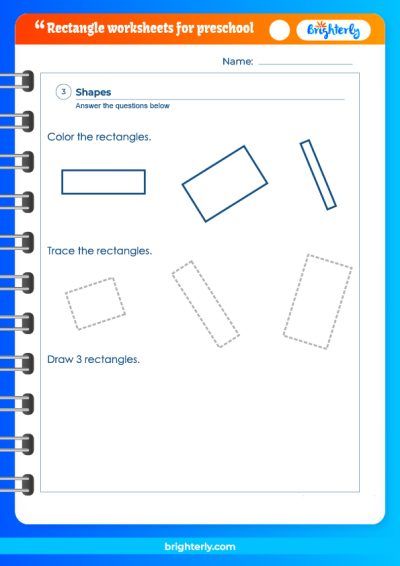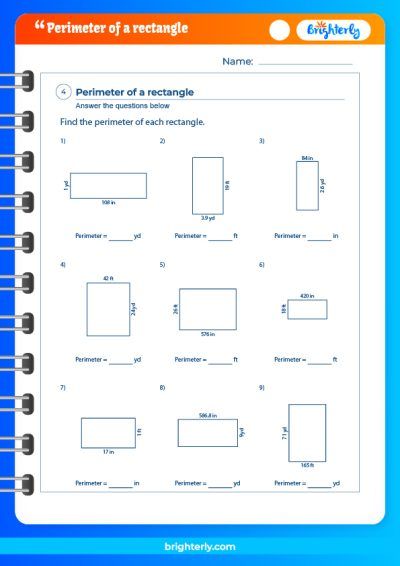Rectangle – Definition, Properties, Area and Perimeter
Updated on January 2, 2024
Welcome to Brighterly, where we make learning math fun, engaging, and easy to understand for kids! Today, we’re taking a journey into the wonderful world of rectangles. Rectangles are an essential building block in the world of geometry and play a significant role in our daily lives. So, put on your thinking caps, and let’s dive into this captivating shape and learn everything there is to know about rectangles!
What is a Rectangle?
A rectangle is a flat, two-dimensional shape with four straight sides and four right angles. This means all four corners are exactly 90 degrees. Rectangles can be found all around us – from the pages of our favorite books to the screens on our devices, the designs of our furniture to the layout of our cities. Mastering the concept of rectangles will open up a whole new world of understanding in math, as well as help you see the beauty of geometry in everyday life.
At Brighterly, we believe that learning should be interactive and enjoyable. So, to better understand rectangles, grab a piece of paper, a pencil, and a ruler. Draw your very own rectangle and observe its properties. By doing this simple activity, you’ll be taking the first step towards mastering this essential geometric shape.
Shape of Rectangle
The shape of a rectangle is defined by its length and width. These two dimensions are always at right angles to each other, forming a perfect “L” shape. When you fold a piece of paper in half along the longer side, you create a rectangle!
Rectangles come in various sizes and proportions, making them a versatile and essential shape in design, architecture, and everyday objects. Have you ever noticed how buildings and city blocks are often rectangular? This is because rectangles can be easily arranged and combined to form larger, more complex structures.
At Brighterly, we encourage you to explore the world around you and discover rectangles in your environment. This hands-on approach will help you develop a deeper understanding of this fascinating shape and its many uses.
So, go on an adventure in search of rectangles! Look for them in your home, at school, or even during a walk around your neighborhood. You’ll be amazed at how many you can find. And as you do, you’ll be building a strong foundation in geometry, all while having fun with the Brighterly way of learning!
Types of Rectangles
There are two main types of rectangles:
- Square: A special type of rectangle where the length and width are equal. All four sides of a square are the same length, and all four angles are 90 degrees.
- Non-square rectangle: A rectangle where the length and width are not equal. The longer sides are called the length, and the shorter sides are called the width. All four angles are still 90 degrees.
Properties of a Rectangle
Some important properties of rectangles include:
- Four straight sides
- Four right angles (90-degree corners)
- Opposite sides are parallel and equal in length
- The sum of interior angles is 360 degrees
Rectangle Formulas
To work with rectangles, you’ll need to know some essential formulas. These will help you calculate the area, perimeter, and diagonal of a rectangle:
- Area: Area is the amount of space inside a shape. The formula for the area of a rectangle is
Area = length × width. - Perimeter: Perimeter is the distance around the outside of a shape. The formula for the perimeter of a rectangle is
Perimeter = 2 × (length + width). - Diagonal: The diagonal of a rectangle is the line segment connecting two opposite corners. The formula for the diagonal of a rectangle is
Diagonal = √(length² + width²).
Remember that Brighterly has the math worksheets to help you practice and master the concept of the rectangle. So, keep practicing and have fun with math!
Diagonal of a Rectangle
The diagonal of a rectangle is a line segment that connects two opposite corners of the rectangle, cutting it into two right-angled triangles. The diagonal has a special relationship with the length and width of the rectangle, as it forms the hypotenuse of the right-angled triangles. You can calculate the length of the diagonal using the Pythagorean theorem:
Diagonal = √(length² + width²)
Perimeter of a Rectangle
The perimeter of a rectangle is the distance around its outer edges. You can calculate the perimeter by adding the length and width and then multiplying by 2:
Perimeter = 2 × (length + width)
Area of Rectangle
The area of a rectangle is the amount of space it occupies in two dimensions. You can calculate the area by multiplying the length by the width:
Area = length × width
Diagonal of a Rectangle
As mentioned earlier, the diagonal of a rectangle is a line segment connecting two opposite corners. It divides the rectangle into two congruent right-angled triangles. The length of the diagonal can be calculated using the Pythagorean theorem:
Diagonal = √(length² + width²)
What Else Can We Call a Rectangle?
A rectangle is also known as an oblong when the length and width are not equal. This term helps distinguish non-square rectangles from squares, which are also considered rectangles.
What is a Diagonal of a Rectangle?
The diagonal of a rectangle is a line segment that connects two non-adjacent vertices or opposite corners of the rectangle. It cuts the rectangle into two right-angled triangles, which are congruent (identical in shape and size). The diagonal serves as the hypotenuse of these triangles, and its length can be calculated using the Pythagorean theorem:
Diagonal = √(length² + width²)
Solved Examples On Rectangle
Example 1: Find the area and perimeter of a rectangle with a length of 7 units and a width of 4 units.
Solution:
Area = length × width = 7 × 4 = 28 square units
Perimeter = 2 × (length + width) = 2 × (7 + 4) = 2 × 11 = 22 units
Example 2: Calculate the length of the diagonal of a rectangle with a length of 10 units and a width of 6 units.
Solution:
Diagonal = √(length² + width²) = √(10² + 6²) = √(100 + 36) = √136 ≈ 11.66 units
Practice Problems On Rectangle
- Find the area and perimeter of a rectangle with a length of 12 units and a width of 5 units.
- Calculate the length of the diagonal of a rectangle with a length of 8 units and a width of 3 units.
- If the area of a rectangle is 35 square units and its length is 7 units, what is the width of the rectangle?
Conclusion
At Brighterly, we’re passionate about making learning math an enjoyable and memorable experience for kids. As we conclude our adventure into the world of rectangles, we hope you have gained valuable insights into this fundamental geometric shape.
Rectangles are a cornerstone in geometry, and understanding their properties, types, and formulas will empower you to tackle various mathematical challenges with confidence. As you explore the world of math, you’ll find that rectangles are just the beginning of a vast and beautiful universe of shapes and concepts.
As you continue on your mathematical journey with Brighterly, remember to approach each new topic with curiosity and enthusiasm. Embrace the hands-on learning approach that we advocate, as it will help you build a strong foundation in mathematics while having fun.
Frequently Asked Questions On Rectangle
What is the difference between a square and a rectangle?
A square is a special type of rectangle where the length and width are equal, while in a non-square rectangle, the length and width are not equal.
Can a rectangle have curved sides?
No, a rectangle must have four straight sides and four right angles.
Are all squares rectangles?
Yes, all squares are rectangles because they have four straight sides and four right angles. However, not all rectangles are squares.






